

Irregular verbs. Phrasals. Liar, liar! - present perfect / past simple game - Breakout English. Have you ever taught the present perfect and past simple to a B1 group?

I definitely have! This is one of my favourite activities to practise present perfect and past simple. Your students ask and answer questions, but the twist is that they have to lie. Then, using their powers of deduction, they have to find out if their partner is lying. It’s OK to lie if you do it as part of a present perfect / past simple game in your English class! Present Perfect vs Past Simple Present perfect and past simple are both grammatical forms which your B1 students should master at this level. Past simple is used to talk about finished actions at a specific time in the past. I ate sushi for dinner last nightWe went to London on holiday 2 years ago.
Present perfect is used to talk about past experiences without a specific time. I have eaten sushi once.Have you ever been to London? The Materials With this communicative activity, you can practise the grammar with a present perfect / past simple game. Download. Simple present tense. The simple present tense is one of several forms of present tense in English. It is used to describe habits, unchanging situations, general truths, and fixed arrangements. The simple present tense is simple to form.
Just use the base form of the verb: (I take, you take, we take, they take) The 3rd person singular takes an -s at the end. (he takes, she takes) The simple present tense is used: To express habits, general truths, repeated actions or unchanging situations, emotions and wishes: I smoke (habit); I work in London (unchanging situation); London is a large city (general truth) To give instructions or directions: You walk for two hundred meters, then you turn left. Great tables to understand English tenses - learn English,grammar,tenses,charts. LearnEnglish - British Council.
Level: beginner The present tense is the base form of the verb: I work in London.
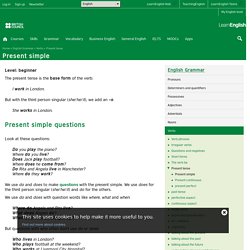
But with the third person singular (she/he/it), we add an –s: She works in London. Low-preparation games to practise present simple questions in English. Cristina Cabal, winner of the British Council's TeachingEnglish blog award, has collected her favourite games for practising the tense that isn't always as simple as its name.

One of the first things people learn when they study English is the present simple form of verbs. However, learners often forget to add the -s ending to the third person singular: Eva walk to work every day. Verb Machine. Gerunds and Infinitives: rules, exercises and quizzes. What is the difference between gerunds and infinitives?

When should you use each? Let's start from the beginning. Click Here for Step-by-Step Rules, Stories and Exercises to Practice All English Tenses. Simple present tense. The simple present tense is one of several forms of present tense in English.
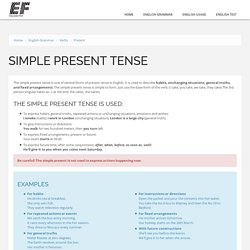
It is used to describe habits, unchanging situations, general truths, and fixed arrangements. The simple present tense is simple to form. Just use the base form of the verb: (I take, you take, we take, they take) The 3rd person singular takes an -s at the end. (he takes, she takes) Classroom activities to teach narrative tenses.
Are you looking for new grammar games for the classroom?
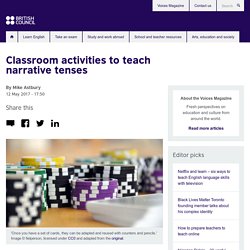
Multiple winner of the TeachingEnglish blog award Mike Astbury shares some resources to download, print, and use in your class. What are narrative tenses? Narrative tenses are verb tenses that are used to talk about the past. You can often find them in stories, textbooks, spoken accounts and in descriptions of past events. The following are examples of narrative tenses: How to Teach Modal Verbs: 4 Simple Steps.
English tenses - learn English,tenses,grammar,charts. Talking about the future lesson plan (1) Present perfect: simple and continuous. Multi-word verbs: Methods and approaches. In this second article I'll look at a range of approaches and methods that I have used to try to help my students with them.
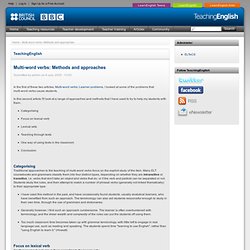
Categorising Focus on lexical verb Lexical sets Teaching through texts One way of using texts in the classroom Conclusion Categorising Traditional approaches to the teaching of multi-word verbs focus on the explicit study of the item. Many ELT coursebooks and grammars classify them into four distinct types, depending on whether they are intransitive or transitive, i.e. verbs that don't take an object and verbs that do, or if the verb and particle can be separated or not. Students study the rules, and then attempt to match a number of phrasal verbs (generally not linked thematically) to their appropriate type. The difference between present simple and continuous tenses. I have already created two posts on the difference between the present simple and continuous tenses.
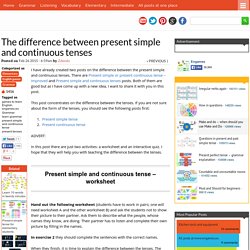
There are Present simple or present continuous tense – improved and Present simple and continuous tenses posts. Both of them are good but as I have come up with a new idea, I want to share it with you in this post. This post concentrates on the difference between the tenses. If you are not sure about the form of the tenses, you should see the following posts first: In this post there are just two activities: a worksheet and an interactive quiz. Questions in the past tense - Games to learn English.
Question formation in general causes problems.
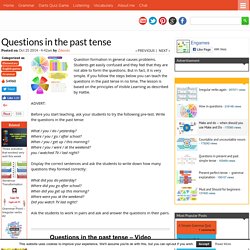
Students get easily confused and they feel that they are not able to form the questions. But in fact, it is very simple. English Grammar Pill: How to use the present perfect tenses correctly. In my last Grammar Pill post, I wrote about the English past tenses and hopefully gave you an idea of how to use the tenses correctly.
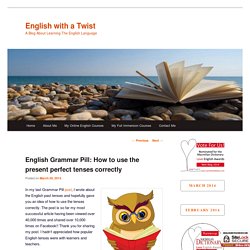
The post is so far my most successful article having been viewed over 40,000 times and shared over 10,000 times on Facebook!! Thank you for sharing my post. I hadn’t appreciated how popular English tenses were with learners and teachers.